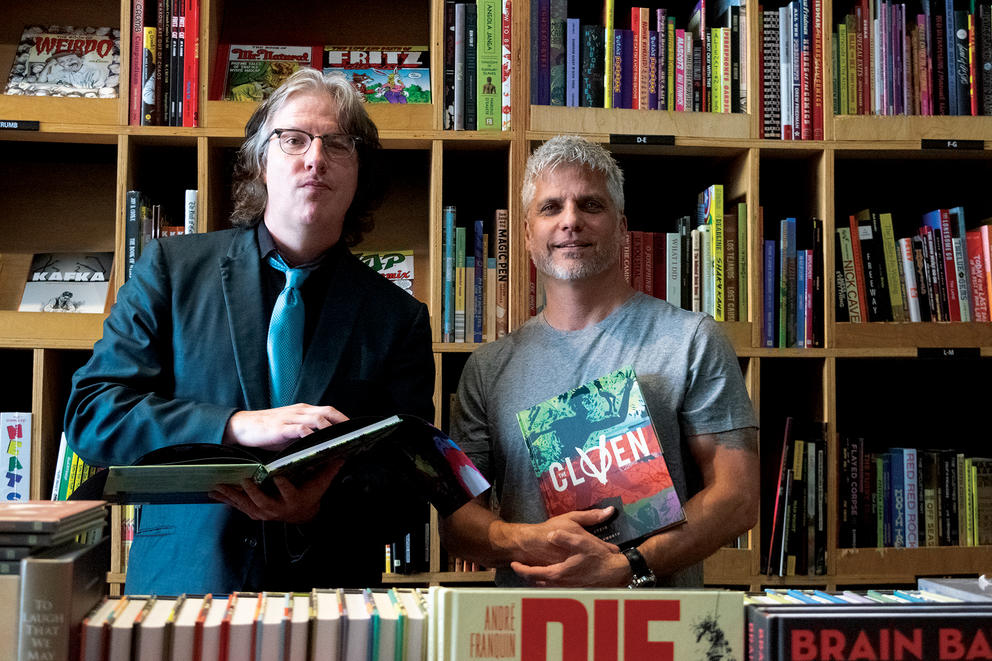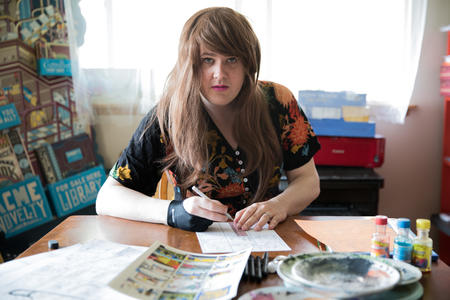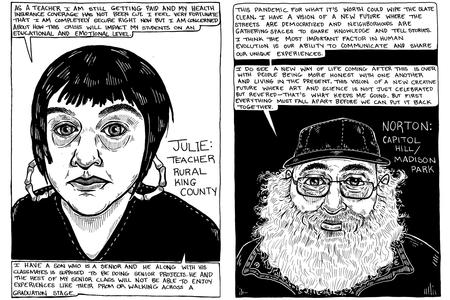A gentle and somewhat naïve kid, Tuck observes the city from the fringes as he hides from his creators and learns that his story is bigger than he ever could have realized. While coming to terms with a world that fears him, Tuck learns that he’s not the only goat-person in the world, and he begins to revel in his differences.
Taking place in current-day Seattle, the action ricochets across town, from Freeway Park to Roosevelt High School to Lake Washington. Locals will recognize something familiar on every page: a moody late-night ferry ride, the villages of tents sprouting under Interstate 5, the moonlit monolith of the water tower at Volunteer Park.
But beyond the thorough recitation of familiar places and names, The Cloven is positively steeped in Seattle. It began as a short story that bestselling local novelist Garth Stein (The Art of Racing in the Rain) wrote for a reading at Capitol Hill’s Hugo House in 2011. With Tuck and his race of lab-engineered goat-people, Stein sought to create a new cryptid to join Sasquatch and the Tree Octopus in the pantheon of weirdly sympathetic Northwest monsters.
Stein expanded the short story into an unpublished novel, but Tuck never quite found his way to the reader through all that prose. Over lunch with Eric Reynolds, the associate publisher of Seattle comics press Fantagraphics Books, Stein related his frustration with the book's progress. Reynolds suggested that Stein get together with Matthew Southworth, a local cartoonist who co-created the gritty Portland-set detective comic (and now TV series) Stumptown. The two hit it off immediately, and The Cloven started down its path to publication as a comic.
At a recent online launch party hosted by Hugo House, Stein admits that he's never been a full-on comics fan, instead "dabbling" in the occasional issue of The Fantastic Four or Mad Magazine in his youth. As someone who has spent his entire career working with prose, translating The Cloven to a visual medium was challenging.
"I'm a novelist," Stein says, "and what I found with working on a graphic novel is you have to write haikus." In a series of free-form, hourslong conversations, he and Southworth collaboratively edited the story down to its essence.
"We would go in and sculpt and trim and do some gardening," Southworth explains, "and it would suddenly be what [Stein] was shooting for."
But writing will get you only so far; a taut script is, at most, half of the necessary ingredients for a good comic. And thanks to Southworth's hand, The Cloven is drop-dead gorgeous. Stumptown demonstrated the illustrator's natural affinity for realistically rendering locations, facial expressions, and body language. But with The Cloven, Southworth brings a kineticism and simplicity to every page that evokes the early-1960s wackadoo myth-making energy of Marvel Comics.
The Cloven is, especially, a testament to how much depth great coloring can grant to a comic. Under Southworth's brush, every page seems rendered in stained glass. There's plenty of comic book-y garishness here: the eerie green of an infant floating in a mad scientist's tube, the glaring red light of a goat-child being born in a sterile laboratory. But more often you'll recognize the colors of Seattle in its palette — slate blues, gritty browns, soulful grays.
It was important to both Stein and Southworth to get the Seattle details right. The reader is seeing the city through Tuck's eyes. It's all new to him, from the wet neon lights of Pioneer Square to the incongruous Ferris wheel on the waterfront to the down-and-out despair of The Jungle, "where the homeless and the cast-offs live."
Stein wrote the story specifically to appeal to Seattle audiences, complete with local in-jokes. "Why not put a weird bio-laboratory financed by a billionaire on Vashon Island? If you're from Seattle, you know that anything weird that happens in Seattle happens on Vashon Island," he explains. (Or perhaps neighboring Maury Island.) "It's just a fact."
Southworth has gone out of his way to render the city as accurately as possible. With just a glance at a few inky brushstrokes in any given panel, most Seattle readers could immediately pinpoint the scene on a map of the city. But how do you capture a city in a static image on a page when that city is going through tremendous upheavals? He and Stein are already hard at work on Book 2 of a projected Cloven trilogy, and Seattle has shifted under their feet multiple times over the past five months alone.
"When we started the book, Capitol Hill was just where The Comet and Elliott Bay Book Company and Everyday Music were," Southworth said. "And now it's the site of this internationally notable uprising. Where there used to be rainbow crosswalks, now there are Black Lives Matter murals on the street."
But there's more than enough room in the series to include as many current events as the creators want. Stein said the idea for telling the story of a lawless clan of outcasts came to him in part out of his frustration at "an enlightened city" with "incredible, vast, massive amounts of wealth on one end of the spectrum, and then on the other, such poverty."
Some readers will take issue with The Cloven's tendency to lean on comic book formula as a kind of origin story shorthand. Anyone who has set foot in a multiplex over the past decade has, by osmosis, absorbed into their DNA the concept of a white-presenting young man who by fluke of science becomes a misunderstood "freak" with the fate of the world in his hands. Southworth and Stein are aware of these clichés, too, and if they don't entirely subvert the now-familiar story, they at least address the overdone tropes quickly and then push them the hell out of the way.
Like some of the best comics, The Cloven works precisely because it mashes up contemporary social commentary and criticism with a playful sense of creative abandon and wild experimentation — all inside a familiar genre framework.
Late in the book comes an especially inventive comic sound effect — now one of my favorite of all time — pasted in alternating red and green stripes behind a curious Tuck's head. It reads, in its entirety: "RUMBLING FOOTFALL LIKE MANY THUNDERING HOOVES THUDDUMTHUDUMMTHUDD." And The Cloven climaxes with a joyous moment, which, in a show-stopping visual flourish that synthesizes all of Fantagraphics' world-class book-design prowess and Southworth's estimable powers of illustration, unfolds into a giant four-page gatefold that pours the ecstatic energy of the story out of the book and into your lap.
So, yes. The Cloven is big and it's loud and it's eager to impress. It’s smart and stunning and struggling with a deepening sense of social awareness. It's colorful and clever and fun and maybe a little too aware of its own strengths — in other words, it’s Seattle, through and through.
Get the latest in local arts and culture
This weekly newsletter brings arts news and cultural events straight to your inbox.











